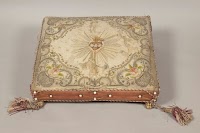 The "Rationale" is one of those vestments that is both rare and yet comes up relatively frequently -- perhaps for reason of its visual prominence -- though usually attached to the question of, "what is it?" The Catholic Encyclopedia has this to say of i…
The "Rationale" is one of those vestments that is both rare and yet comes up relatively frequently -- perhaps for reason of its visual prominence -- though usually attached to the question of, "what is it?" The Catholic Encyclopedia has this to say of i…
Our Advertising Partners
-
The global pandemic has disrupted the normal celebration of the Holy Week in Spain, where, for a second year, the government has forbidden t...
-
The mitre is one of the most recognizable symbols of prelates of the Church, specifically of bishops up to the Roman pontiff himself -- thou...
-
We live in a very visual, image-based culture and, what's more, there is always lots of curiosity around the matter of traditional papal...
-
Above is an image of Pope John XXIII after his death in 1963, dressed in red vestments for burial (the arms on the front of the chasuble app...
-
To the person who simply enjoys beautiful art and architecture, distinctions like "baroque" or "rococo" might seem overl...
-
The papal blessing known as the Benedictio Coram Populo, or more commonly as the Urbi et Orbi (to the city [of Rome] and to the world) bless...
Blog Archive
-
▼
2020
(252)
-
▼
February
(20)
- The Rationale
- The Incense Boat
- A Vestment by Gothic Revival Master Sir Ninian Com...
- Church of the Assumption Restored by Conrad Schmit...
- The Ongoing Evolution of a Newly Commissioned Trad...
- Some Forms of the Thurible or Censer
- Scourges, Maniples and More
- Reconstruction of the Church of St. Cecilia in the...
- Two Ornamental Bindings from Brindisi
- Seven Holy Founders Altar in the Basilica of Our L...
- Prelatial Dress of the Religious Orders: The Domin...
- Before and After: St. Elizabeth Ann Seton in Picke...
- Book Notice: An Important Catalogue of Vestments f...
- An "Arma Christi" Chasuble from Poland
- On Septuagesimatide and Carnival
- A 19th Century Chasuble in Silver Lamé
- Terracotta Altar Cards Seen in the Holy Land
- An Embroidered Lenten Chasuble from Vilnius, Lithu...
- The Missal Cushion
- Curiosities of the Ancient Papal Mass: The Fistula
-
▼
February
(20)
Donate
Copyright ©
Liturgical Arts Journal | Powered by Blogger


































